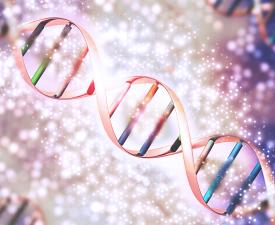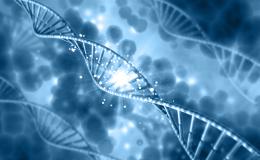New Study Shows Jumping Genes Can Protect Against Blood Cancer
July 28, 2021
When we think about the human genome, or the instructions used to create the human body that are stored as DNA in virtually every cell, we often think of a static, unchanging instruction manual.

In reality, our instruction manual (genome) is continually being copied within our cells, and sometimes the proteins responsible for copying our DNA make mistakes. If we’re lucky, the “autocorrect” function (proofreading DNA polymerase) will catch the mistake and correctly fix the “spelling” error. Otherwise, we may end up with a gene with incorrect instructions, like a stellar autocorrect fail.
It turns out that these genetic “misspellings” can wreak havoc on the cell. If the error occurs in the middle of a gene responsible for controlling the cell cycle, the mistake can change the gene, and in many cases, render the gene product nonfunctional. A cell may not lose control of cell replication if one cell cycle control gene in the genome is nonfunctional, but the likelihood that a cell will lose control of replication increases with each gene variant that changes the function of a gene involved in cell cycle regulation. A cell becomes cancerous once it has lost control of cell replication and divides uncontrollably.
So what causes the genome to change? Mutagens, such as tobacco smoke and ultraviolet light, are capable of creating errors in the genome. DNA polymerase, the protein responsible for copying our DNA to replicate our cells, is also thought to make a mistake in one out of every 10,000 to 100,000 nucleotide bases,1 or “letters.” Many of these errors are fixed through DNA polymerase proofreading, but not every error will be corrected. Other genetic “spelling” changes can occur through less stable elements of the genome, called transposons.
Transposons are often referred to as “jumping genes,” which is a fairly accurate representation of their activity in the genome. In their inactive state, transposons are stretches of DNA with a static location in the genome. They just sit there. Alternatively, when the transposon is activated, the transposon replicates and inserts itself throughout the genome, similar to copying and pasting a block of text randomly throughout an instruction manual. You can imagine what randomly pasting a phrase could do to the readability of any physical instruction manual, and the genome is no different. Transposons can often land in the middle of gene sequences and change the function of the gene product.
Altering the function of a large number of genes can have a variety of effects on the cell, one of which is the loss of cell cycle control and the development of a cancerous cell. In fact, almost half of all cancers contain the L1 (retro)transposon inserted into another gene; this is especially true for lung, colorectal and head and neck cancers.2 Another possible effect of transposon activation is the triggering of a DNA damage response which either causes cell death or renders the cell incapable of replication.
A genetic research team from the University of Texas Southwestern Medical Center recently designed a study to investigate which genes are essential for the survival of acute myeloid leukemia (AML) cells, the blood cancer with the worst prognosis for both adults and children.2 The researchers created special guide RNAs (sgRNAs) designed to render targeted genes in AML cells nonfunctional using the CRISPR/Cas9 genome editing tool. By making some genes in AML cells nonfunctional, the researchers could determine which genes are necessary for the survival of the cancerous cells. In other words, after changing the function of genes in AML cells, the cancer cells that survive are sequenced and “spell-checked” to find which genes are altered and, therefore, not necessary for AML cell survival.
The researchers made a remarkable discovery after completing their screen: A gene responsible for preventing transposon activation (MPP8) was necessary for AML cancer cell survival. This result was somewhat counterintuitive, given the prevalence of transposon gene insertions in nearly half of all cancers. Further study revealed that the MPP8 gene product is responsible for blocking the replication of the L1 (retro)transposon in AML cells. Inactivation of MPP8 activated L1 replication and insertion, triggering the DNA damage response in AML cells. In other words, without the MPP8 gene product, the L1 sequence inserts itself randomly throughout the AML cell genome, triggering the DNA damage response and killing the cancer cell or preventing the cell from replicating.
Selectively killing cancer cells and/or suppressing their ability to replicate are two of the primary goals of effective cancer therapies. The research team hopes their discovery will facilitate the development of new, unique cancer therapies aimed at targeting blood cancer cells through transposon activation or other DNA damage. The study may additionally provide a mechanistic explanation for why many AML cancers are particularly sensitive to DNA damage-inducing therapies.
Genetic research discoveries, like the effect of transposon activity on blood cancer cells, will continue to facilitate the development of new, more effective therapies for cancer. Earlier diagnosis of cancer can make a profound impact on the prognosis of the disease, regardless of the treatments available for a particular cancer. Hereditary cancer syndromes, which are caused by a pathogenic gene variant that can be passed from parent to child, can be detected prior to the development of cancer. Establishing the presence of a pathological gene variant can facilitate personalized disease monitoring and mitigation depending on the increased cancer risk a particular gene variant confers. Kailos Genetics developed the ExpedioTM Hereditary Cancer Screening test to screen for variants in 33 genes associated with hereditary cancer syndromes. Click here to learn more about ExpedioTM, or contact us with any questions you may have regarding genetic screenings.




